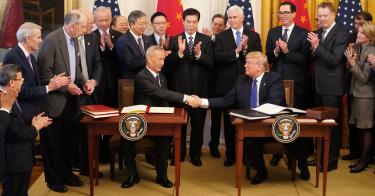January 15 marks one year since the U.S. and China signed a bilateral agreement, known as the Phase One deal, establishing new rules on trade.
After a full year, and as a new administration and Congress assume power, it’s important to evaluate the effectiveness of the deal at achieving its goals.
It’s not a pretty picture.
The dispute between the U.S. and China came with a hefty price tag. Americans have paid tens of billions in extra taxes to trade with China since 2018, as well as billions of dollars in subsidies to farmers. At the same time, it did nothing to further U.S. strategic objectives.
The incoming Biden administration will be tasked with setting the future course for trade with China. First steps should undoubtedly focus on the elimination of tariffs imposed on $360 billion in imports from China and retaliatory tariffs China has imposed on U.S. goods.
Cutting tariffs will help businesses to keep essential employees and help to keep prices down. Both things help families stretch each dollar a little further.
The Phase One deal stems from an investigation conducted by the Office of the U.S. Trade Representative in August 2017 under Section 301 of the Trade Act of 1974.
It found that China’s policies regarding technology transfer cost the economy $50 billion annually. In response to the findings, the U.S. imposed tariffs on $50 billion worth of imports from China. China retaliated, and the dispute escalated from there.
Those tariffs on imports from China could have a lasting effect on the economy. One study found that in the short term, tariffs of 25% on $250 billion worth of imports from China would cost a family of four $767 a year and reduce existing jobs by more than 900,000.
By the end of 2019, the average tariff rate for Americans to purchase from China had increased from 3.1% to 21%. The cost for the Chinese people to purchase from the U.S. increased from 8% to 21.1% over the same period.
After several months of escalating tensions, the two sides reached the Phase One deal, which slightly lowered average tariff rates to 19.3% and 20.3%, respectively.
The Phase One deal contains substantive chapters on intellectual property, technology transfer, agriculture, financial services, and exchange rates, as well as enforcement mechanisms to ensure that both sides lived up to the agreement. China also agreed to significantly increase its annual purchases of goods from the U.S.
Outgoing U.S. Trade Representative Robert Lighthizer contends that the Phase One deal has been a success. Lighthizer recently told the Wall Street Journal: “We changed the way people think about China. We want a China policy that thinks about the geopolitical competition between the United States and an adversary—an economic adversary.”
It’s unclear how effective the deal’s rule changes have been, but China certainly won’t fulfill the Phase One purchasing commitments for 2020. Far from it.
At the same time, the deal has come with immense costs. The deal did not mean the end of high tariffs, as most of the tariffs imposed leading up to the deal remain in place today.
Americans have paid $74.2 billion in extra taxes to import from China since 2018. That does not include the harm that American farmers and other industries have faced due to retaliation by China. American families also footed the bill for the government to spend more than $24 billion between 2018 and 2019 on subsidies for farmers.
President-elect Joe Biden has signaled that he intends to have a multilateral strategy vis-a-vis China, and Katherine Tai, Biden’s presumptive nominee to succeed Lighthizer as U.S. trade representative, has advocated for a more strategic approach for U.S.-China trade relations.
Tai said in August that “[trade policy] has got to be about what we are going to do to make ourselves and our workers and our industries and our allies faster, nimbler, be able to jump higher, be able to compete stronger, and ultimately be able to defend this open democratic way of life that we have.”
There’s no doubt that the U.S. and China are engaged in strategic competition. The use of punitive tariffs, however, has proven a poor instrument to effect change in China.
Americans have been hurt by the trade war with China, and the price of that dispute grows each day. Cutting tariffs should be a key component of Biden’s strategy towards China.
This piece originally appeared in The Daily Signal



